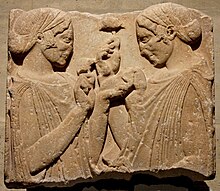
Back Estil sever Catalan Strenger Stil German Αυστηρός ρυθμός Greek Estilo severo Spanish Ankara tyyli Finnish Sculpture grecque classique#Le style sévère (480 - 450) French Estilo severo Galician Stile severo Italian Stilo Sebero MWL Tidlig klassisk stil NB

The Severe style, or Early Classical style,[1] was the dominant idiom of Greek sculpture in the period ca. 490 to 450 BCE. It marks the breakdown of the canonical forms of archaic art and the transition to the greatly expanded vocabulary and expression of the classical moment of the late 5th century. It was an international style found at many cities in the Hellenic world and in a variety of media including: bronze sculpture in the round, stelae, and architectural relief. The style perhaps realized its greatest fulfillment in the metopes of the Temple of Zeus, Olympia.
The term severe style was first coined by Gustav Kramer in his Über den Styl und die Herkunft der bemahlten griechischen Thongefäße ("On the style and the origins of painted Greek pottery", 1837, Berlin) in reference to the first generation of red figure vase painters; since Vagn Poulsen's 1937 study Der strenge Stil ("The Severe Style"), the name has become exclusively associated with sculpture.
- ^ Also called the Strong Style, see T.B.L. Webster, Greek Art and Literature, 530-400 BC Oxford, 1939, p.45 ff
© MMXXIII Rich X Search. We shall prevail. All rights reserved. Rich X Search